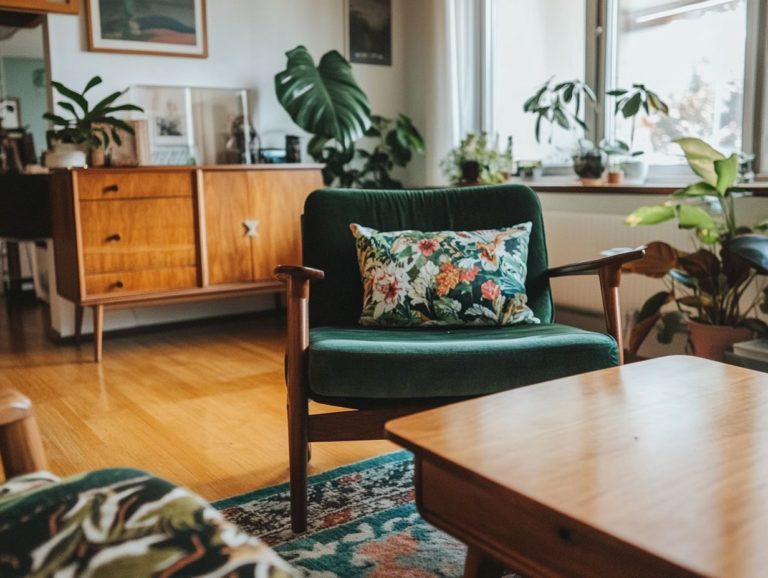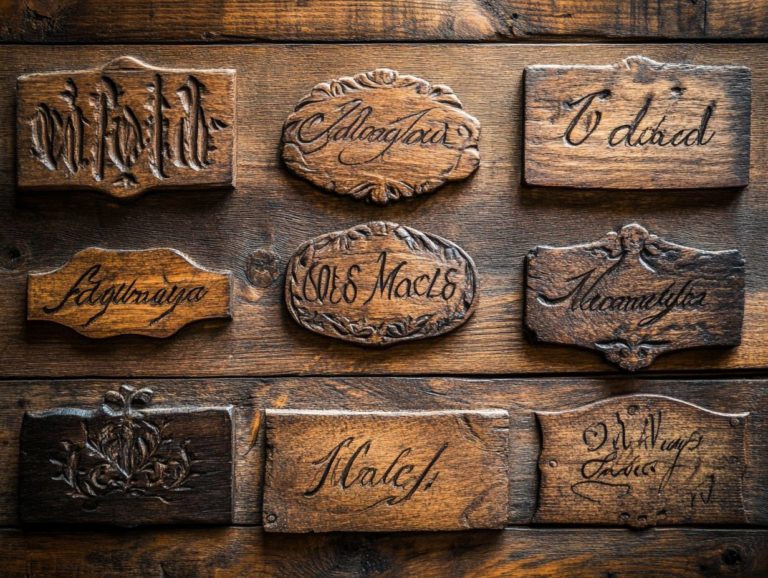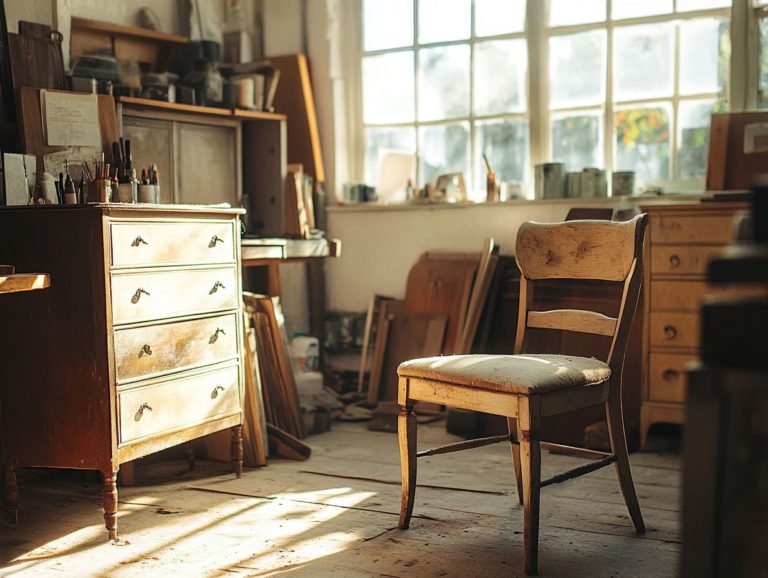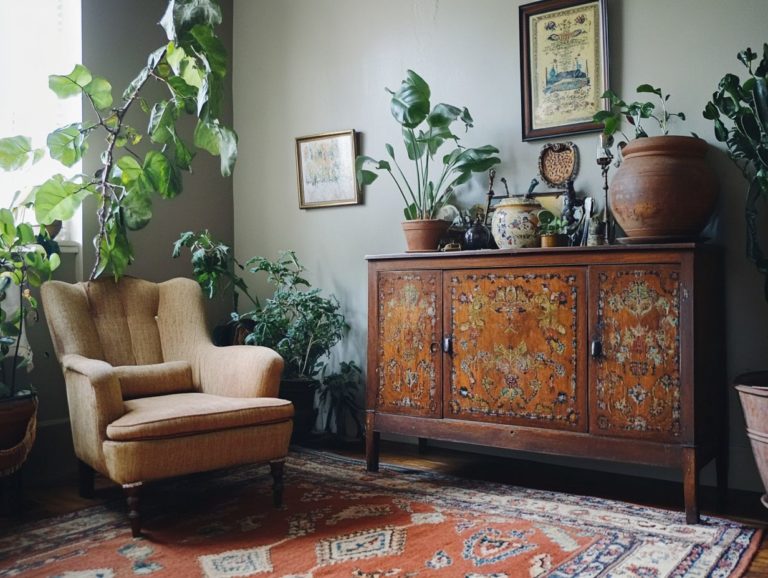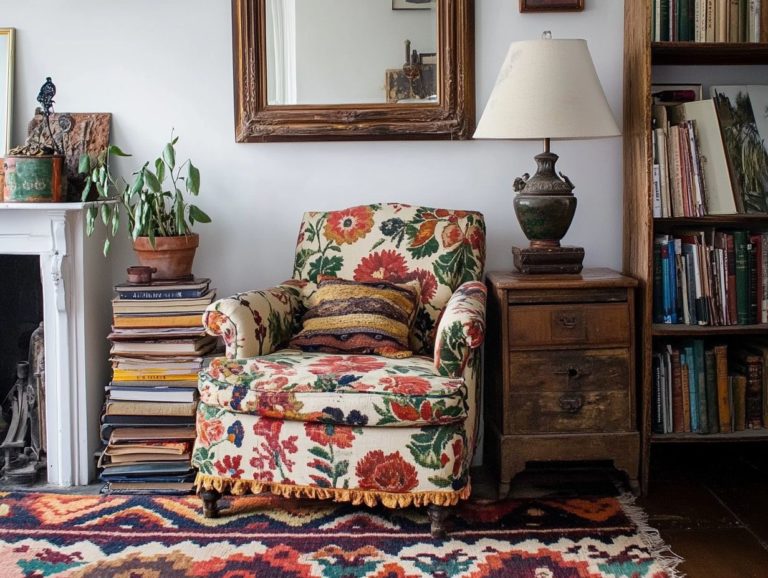Tips for Selling Vintage Furniture Online
Selling vintage furniture online opens doors to profit while helping the planet! You’ll reach more buyers and promote sustainability.
Thanks to the rise of online marketplaces, you can effortlessly list your unique pieces for resale, drawing in buyers who appreciate both antique and stylish furniture from the middle of the 20th century.
The convenience of digital platforms allows you to showcase your inventory and engage with a community that shares your passion for quality craftsmanship and historical design all from the comfort of your home.
This shift boosts your visibility and simplifies marketing, as social media and specialized forums become powerful allies in reaching fellow enthusiasts.
Weaving engaging stories around each piece’s historical significance fosters a deeper connection with potential buyers. By embracing sustainable selling practices, you contribute positively to the environment, promoting the reuse of vintage items instead of adding to fast furniture trends.
By leveraging online platforms that expertly connect eager buyers with unique offerings, you position yourself at the center of a vibrant and eco-conscious marketplace.
Contents
- Where to Find Vintage Furniture to Sell
- Key Takeaways:
- Preparing and Staging Vintage Furniture for Online Sales
- Effective Online Marketing Strategies for Vintage Furniture
- Pricing and Negotiating for Vintage Furniture
- Key Takeaways:
- Where to Find Vintage Furniture to Sell
- Preparing and Staging Vintage Furniture for Online Sales
- Effective Online Marketing Strategies for Vintage Furniture
- Utilizing Social Media and Online Marketplaces
- Pricing and Negotiating for Vintage Furniture
- Factors to Consider and Tips for Successful Negotiations
- Shipping and Packaging Vintage Furniture
- Dealing with Returns and Customer Service
- Frequently Asked Questions
Where to Find Vintage Furniture to Sell
Get ready to dive into a treasure hunt for unique pieces! Finding vintage furniture to sell involves various sourcing methods, ranging from local auctions to online marketplaces designed for collectors.
Each avenue presents unique items that are sure to captivate discerning buyers, whether you’re exploring thrift stores, estate sales, or digital platforms like eBay and Facebook Marketplace.
Best Places to Source Vintage Furniture
The best places to source vintage furniture often lie within antique malls, online marketplaces, and community auctions, each offering carefully chosen items that cater to your distinct style.
Consider venues like the Brimfield Antique Show, Americas Antique Mall, or Antique Village in Fairborn. These places provide thrilling opportunities to discover everything from Mid-Century Modern chairs to ornate Victorian tables while enjoying the art of negotiation with knowledgeable vendors.
Online marketplaces such as Etsy and Facebook Marketplace provide a straightforward way to hunt for specific items, connecting you directly with sellers for personalized transactions.
Community auctions, often hosted in your local area, foster camaraderie among participants while unveiling one-of-a-kind treasures that you might not encounter elsewhere. This makes them a rewarding avenue for anyone passionate about sourcing unique vintage furniture.
Key Takeaways:
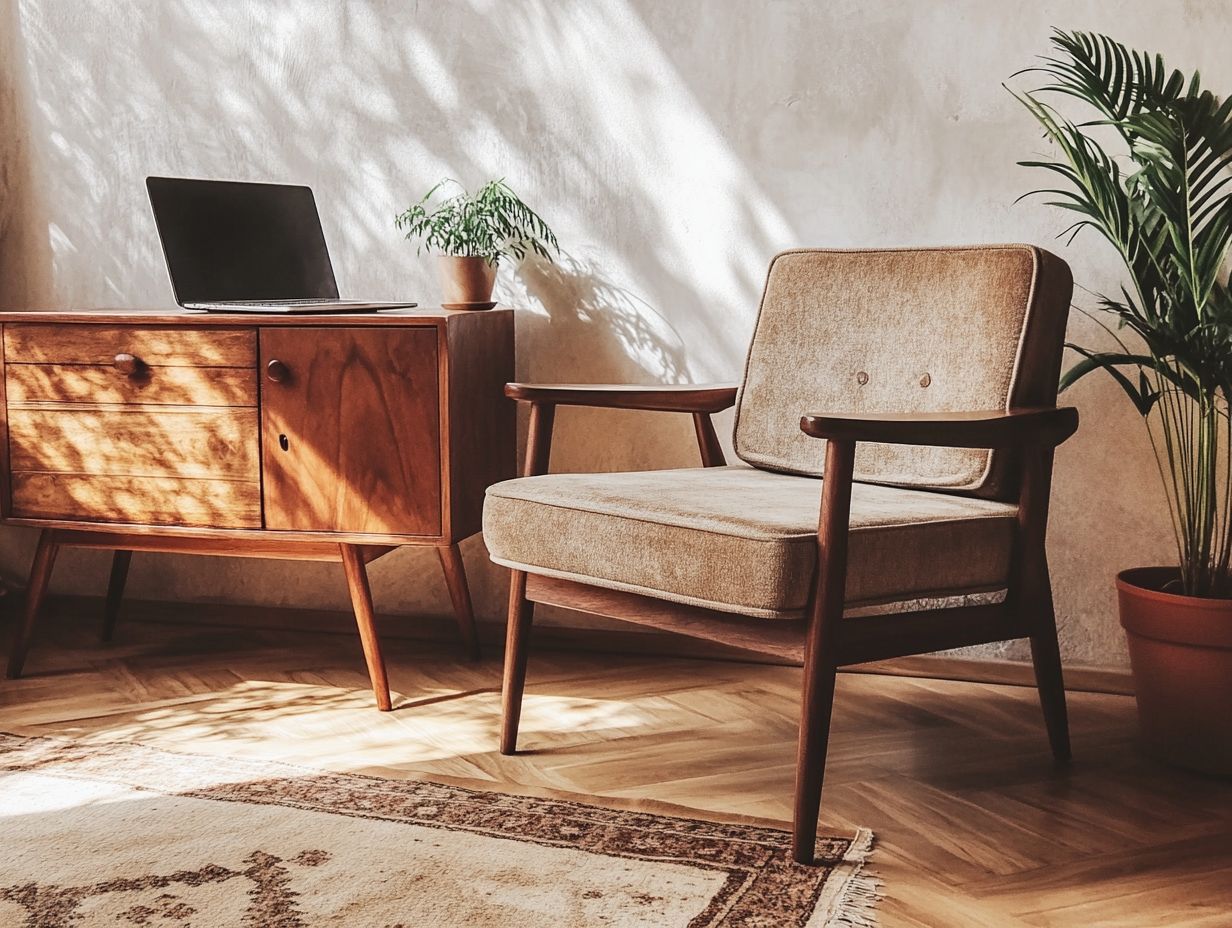
- Source vintage furniture from reputable places like thrift stores, estate sales, and online auctions to ensure authenticity and quality.
- Clean, repair, and style vintage furniture to enhance its appeal and value for online sales.
- Use social media and online marketplaces for effective marketing and carefully consider pricing strategies for successful sales.
Preparing and Staging Vintage Furniture for Online Sales
Preparing and staging vintage furniture for online sales is key to attracting discerning buyers and showcasing these unique pieces in their best light.
Effective staging goes beyond cleaning and restoration. It requires capturing high-quality photos that highlight the craftsmanship and style of each item. By attending to every detail, you can create an attractive online profile that resonates with collectors and buyers who appreciate the historical significance of vintage and antique furniture.
Cleaning, Repairing, and Styling Tips
Cleaning, repairing, and styling vintage furniture are crucial steps that enhance both the quality and allure of each piece, making them more appealing to potential buyers.
A thorough cleaning not only preserves the craftsmanship and materials but also showcases the unique design features of these items.
When restoring, maintain the original condition while making repairs that can boost both value and aesthetic appeal.
To achieve the best results, use gentle cleaning solutions, such as a mixture of mild soap and water, to protect the wood finish. For upholstery, steam cleaning revitalizes fabric without harsh chemicals.
For repairs, use wood glue for joints or add small clamps to maintain the integrity of the piece and enhance its longevity.
Applying natural oils or wax can enrich the wood’s luster and align with contemporary decor trends that prioritize sustainability. Styling these vintage treasures with modern accessories creates a striking contrast, appealing to diverse tastes and preferences.
Effective Online Marketing Strategies for Vintage Furniture
Implementing effective online marketing strategies for vintage furniture is essential for sellers aiming to reach a broad audience and engage with potential buyers who appreciate unique pieces.
Leverage social media platforms and online marketplaces to boost your visibility and establish a prominent presence in the vintage furniture community.
Using the right marketing tools allows you to highlight the historical significance and eco-friendly features of your offerings, attracting both collectors and buyers who share your passion.
Utilizing Social Media and Online Marketplaces
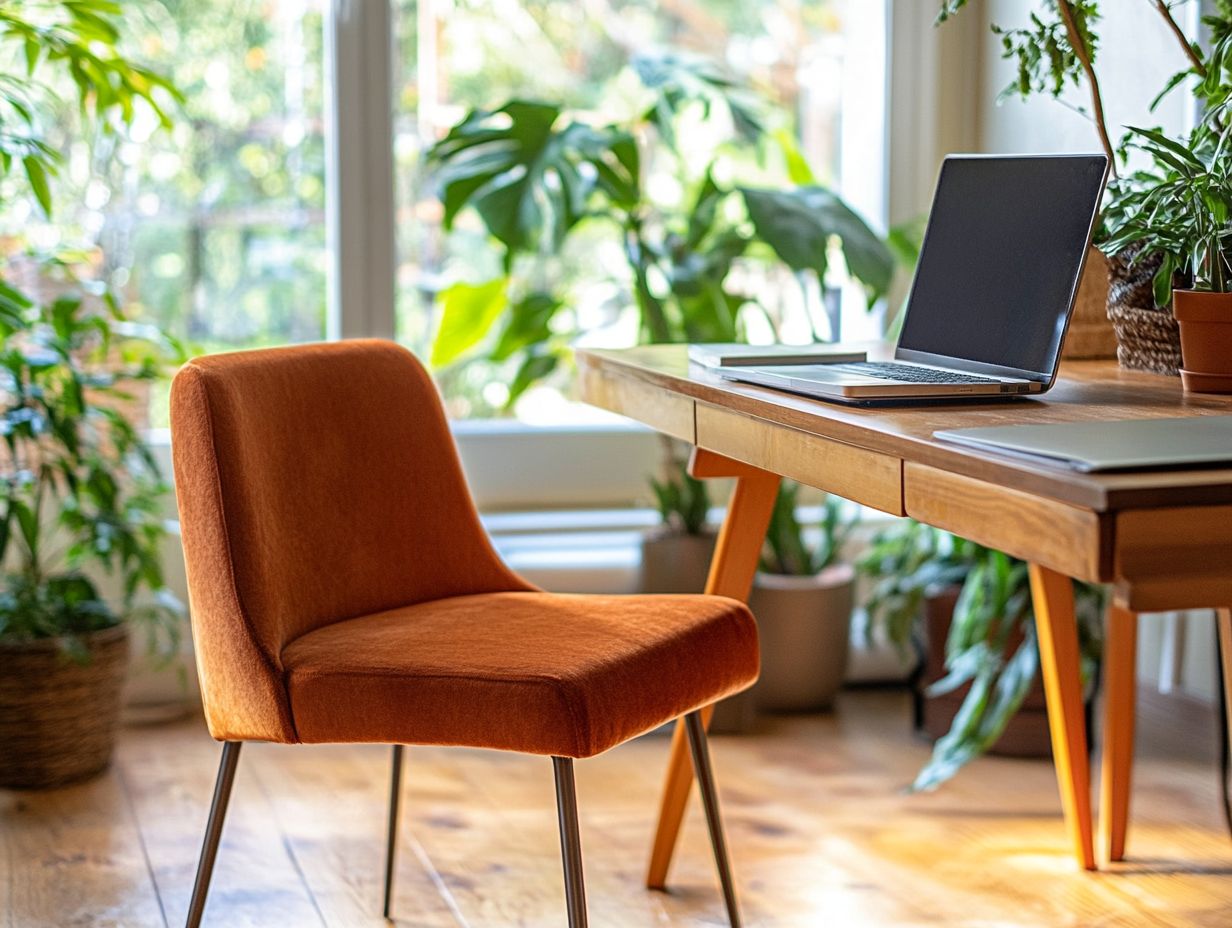
Selling vintage furniture online is exciting! Social media and marketplaces connect you to a passionate community of collectors and buyers. Platforms like Facebook Marketplace and Instagram let you showcase your unique pieces through engaging posts and targeted advertisements.
Create eye-catching content that highlights the distinct features and history of each item think visually stunning photos, captivating storytelling, and informative videos.
Community interaction is key. By responding to comments and engaging with your followers, you foster a loyal customer base.
Online marketplaces are essential for transactions and enhancing your brand identity. These platforms broaden your audience and encourage positive reviews and word-of-mouth referrals, both vital for success in the vintage furniture market.
Pricing and Negotiating for Vintage Furniture
Establishing an effective pricing strategy and honing your negotiation skills for vintage furniture is crucial for maximizing profits and captivating potential buyers.
By understanding the market value of unique pieces considering age, condition, and quality you can confidently determine the right asking price.
Be flexible in negotiations to encourage successful transactions that satisfy both buyers and sellers, enriching your experience within the vibrant vintage furniture community.
Factors to Consider and Tips for Successful Negotiations
When negotiating for vintage furniture, several key factors can lead to favorable outcomes for both parties involved. Understanding the unique characteristics of each piece its age, craftsmanship, and condition provides essential context for establishing a fair price.
Recognizing your motivations and budget makes the negotiation process smoother, allowing you to align your expectations with what the seller may offer.
Market demand is another crucial element; it influences how much you re willing to invest. Staying informed about current trends helps you understand which styles are in vogue and allows you to tailor your approach accordingly.
Engaging effectively with sellers is vital. Highlight not just the history of the piece, but also how it integrates into modern living spaces to strengthen your position. Practicing clear and assertive communication is essential for exuding confidence during negotiations.
Selling vintage furniture online lets you turn your passion into profit!
Thanks to the surge of online marketplaces and social media platforms, connecting with potential buyers has become simpler than ever.
This guide will walk you through every step of the journey, from sourcing breathtaking pieces to marketing them effectively.
Discover how to prepare, stage, and price your furniture, navigate the complexities of shipping logistics, and deliver exceptional customer service.
Get ready to transform your vintage treasures into thriving sales!
Key Takeaways:
- Source vintage furniture from trusted places like thrift stores and estate sales.
- Clean and repair vintage pieces to boost their appeal and value.
- Use social media and online marketplaces to market your furniture effectively and consider key factors when pricing and negotiating for successful sales.
Why Sell Vintage Furniture Online?
Selling vintage furniture online is your gateway to a lucrative opportunity. It connects you with a wider audience while championing sustainable practices. The rise of online marketplaces allows you to effortlessly list your unique pieces for resale, drawing in buyers who appreciate both antique and mid-century modern styles. Digital platforms enable you to showcase your inventory and engage with a community that shares your passion for quality craftsmanship and historical design all from the comfort of your home.
This shift boosts your visibility and simplifies marketing. Social media and specialized forums become powerful allies in reaching fellow enthusiasts. Weaving engaging stories around each piece’s historical significance fosters a deeper connection with potential buyers. By embracing sustainable selling practices, you contribute positively to the environment, promoting the reuse of vintage items instead of adding to the waste produced by fast furniture trends.
By leveraging online platforms that expertly connect eager buyers with unique offerings, you position yourself at the center of a vibrant and eco-conscious marketplace.
Where to Find Vintage Furniture to Sell
Finding vintage furniture to sell involves exploring diverse sourcing methods, ranging from local auctions to online marketplaces designed for collectors.
The vintage furniture market brims with opportunities. Knowing where to direct your gaze can unveil valuable treasures in both antique and mid-century modern styles.
As you explore thrift stores, estate sales, or digital platforms like eBay and Facebook Marketplace, each avenue presents unique pieces that are sure to captivate discerning buyers.
Ready to dive in? Start your journey today and discover the excitement of selling vintage furniture!
Best Places to Source Vintage Furniture
The best places to source vintage furniture often lie within antique malls, online marketplaces, and community auctions. Each of these offers a curated selection of unique pieces that cater to your distinct style and preferences.
For example, antique malls like the Brimfield Antique Show or the Antique Village in Fairborn provide an immersive experience. Here, you can discover everything from Mid-Century Modern chairs to ornate Victorian tables. Enjoy the exhilarating art of negotiation with knowledgeable vendors!
Online marketplaces like Etsy and Facebook Marketplace offer a straightforward way to hunt for specific items. They connect you directly with sellers for a more personalized transaction.
Community auctions, often hosted right in your local area, foster a sense of camaraderie among participants. They frequently unveil one-of-a-kind treasures that you might not encounter elsewhere, making them a rewarding avenue for anyone passionate about sourcing unique vintage furniture.
Preparing and Staging Vintage Furniture for Online Sales
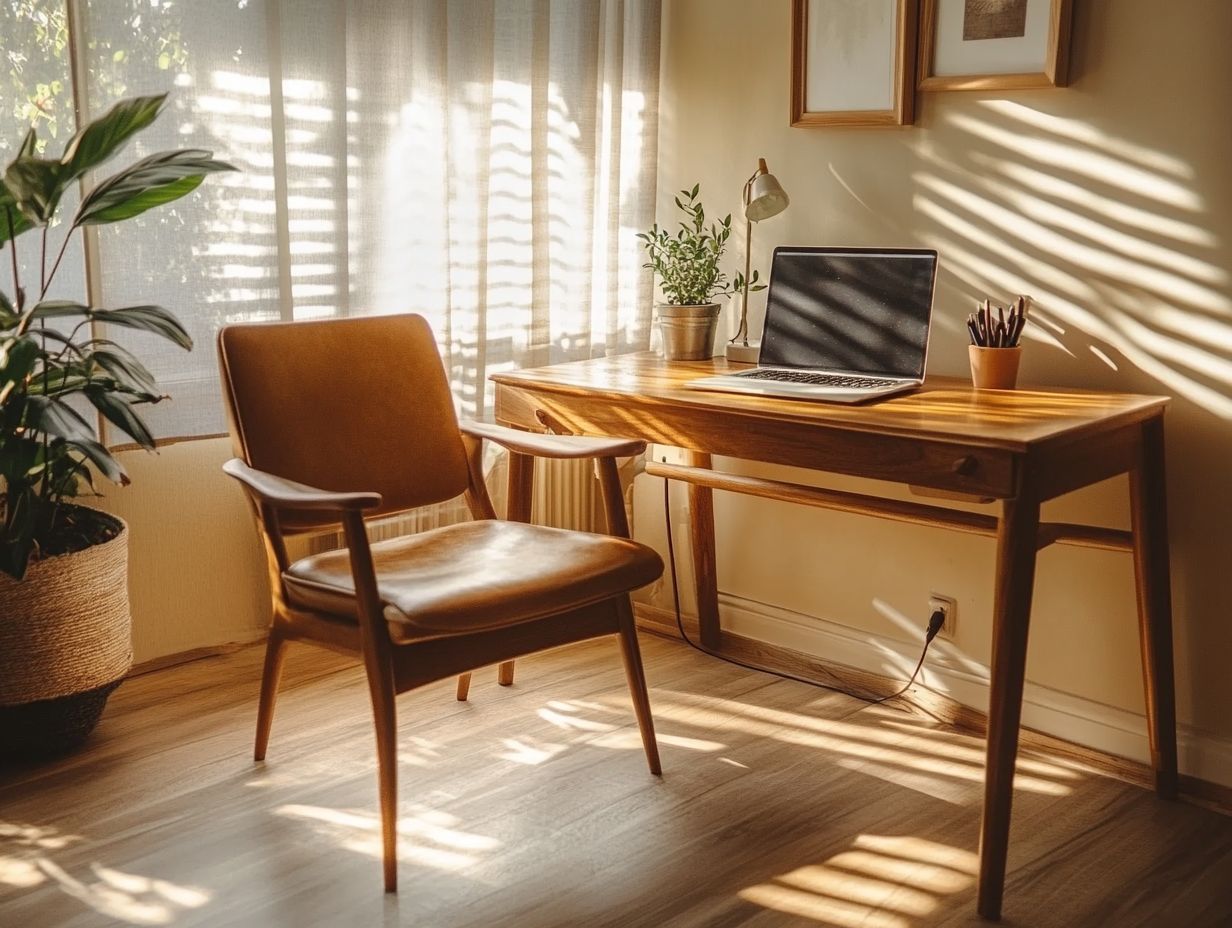
Preparing and staging vintage furniture for online sales is key to attracting discerning buyers. Showcasing these unique pieces in their best light is essential.
Effective staging goes beyond cleaning and restoration. It involves capturing high-quality photos that highlight the skill in making things by hand and style of each item. By meticulously attending to every detail, you can cultivate an enticing online presence that resonates with collectors and buyers who truly appreciate the historical significance of vintage and antique furniture. It’s also important to understand what to look for when buying vintage furniture to ensure quality and authenticity.
Cleaning, Repairing, and Styling Tips
Cleaning, repairing, and styling vintage furniture are crucial steps that enhance both the quality and allure of each piece. A thorough cleaning preserves the craftsmanship and materials while showcasing the unique design features that set these items apart.
When restoring, it s vital to maintain the original condition. Make necessary repairs that can significantly boost both value and aesthetic appeal.
For the finest results, consider using gentle cleaning solutions, like a mixture of mild soap and water, to protect the wood finish. For upholstery, steam cleaning revitalizes fabric without harsh chemicals.
For repairs, using wood glue for joints or adding small clamps can help maintain the piece’s integrity while enhancing its longevity. Applying natural oils or wax enriches the wood’s luster and aligns beautifully with contemporary decor trends that prioritize sustainability.
Styling these vintage treasures with modern accessories creates a striking contrast, appealing to a diverse array of tastes and preferences.
Effective Online Marketing Strategies for Vintage Furniture
Implementing effective online marketing strategies for vintage furniture is essential for you as a seller aiming to reach a broad audience. Engage with potential buyers who appreciate unique pieces.
By leveraging social media platforms and online marketplaces, you can boost your visibility. Establish a prominent presence within the vintage furniture community.
Utilizing the right marketing tools and techniques allows you to highlight the historical significance and sustainable aspects of your offerings. This attracts both collectors and buyers who share your passion.
Don t miss out on finding unique treasures! Start your search today and uncover vintage gems that tell a story!
Utilizing Social Media and Online Marketplaces
Social media and online marketplaces are essential for selling vintage furniture. They allow you to connect directly with a wider community of collectors and buyers. Platforms like Facebook Marketplace and Instagram let you showcase your unique pieces through engaging posts and targeted advertisements.
To make the most of this opportunity, create eye-catching content that highlights the distinct features and history of each item. Think visually stunning photos, captivating storytelling, and informative videos. Community interaction is key; by responding to comments and engaging with your followers, you foster a loyal customer base.
Online marketplaces are vital tools for making sales easier and enhancing your brand identity. These platforms broaden your audience for listings and help you get positive reviews and word-of-mouth referrals, both essential for sustained success in the vintage furniture market. If you’re looking to expand your offerings, check out where to buy vintage furniture online.
Pricing and Negotiating for Vintage Furniture
Setting the right price is key for maximizing profits while captivating potential buyers. By grasping the market value of unique pieces considering elements like age, condition, and quality you can confidently determine the right asking price.
A flexible approach to negotiation can pave the way for successful transactions that leave both buyers and sellers satisfied, enriching your experience within the vibrant vintage furniture community.
Factors to Consider and Tips for Successful Negotiations
When negotiating for vintage furniture, understanding the unique characteristics of each piece its age, craftsmanship, and condition helps you understand the fair price.
Knowing your goals and budget can help during negotiations, allowing you to align your expectations with what the seller may offer.
Market demand influences how much you re willing to invest. Staying informed about current trends will help you understand which styles are in vogue and tailor your approach accordingly.
Engaging effectively with sellers is vital. Highlighting the history of the piece and how it integrates into modern living spaces can strengthen your position. To communicate clearly and confidently is essential.
Providing comprehensive information about the furniture’s history of ownership and unique features will naturally elevate its perceived value, making it all the more appealing to you as a prospective buyer in your homes and decorating choices.
Shipping and Packaging Vintage Furniture
When shipping vintage furniture, pay close attention to details. This ensures that these delicate treasures arrive in pristine condition and safeguards your reputation as a seller, especially when utilizing platforms such as Facebook Marketplace or eBay.
By using the best packaging methods selecting the right materials and employing effective techniques you can protect these unique pieces during transit, just as esteemed appraisers would recommend.
As you navigate the intricacies of shipping, grasping the logistics involved becomes essential for delivering exceptional service to your buyers, particularly if selling items from the mid-century modern furniture era.
Start showcasing your pieces today!
Best Practices for Shipping and Packaging Fragile Items

Best practices for shipping and packaging fragile items, particularly vintage furniture, are essential to ensure that each unique piece arrives safely at its destination. This is especially important for items with unique makers and marks.
Utilize high-quality packing materials, like bubble wrap and sturdy boxes, to significantly reduce the risk of damage during transit. When collecting vintage finds from various sources, don t forget to label your packages clearly to prevent mishaps!
Providing detailed handling instructions will further safeguard your valuable items throughout the shipping process. Fill those empty spaces with foam padding or packing peanuts to keep your treasures safe and prevent movement that could lead to breakage, especially with fragile decorative items from Americas Antique Mall.
When wrapping individual pieces, consider using protective corners to help keep items safe, and ensure that each item is secured with materials designed to absorb shocks. Clear labeling not only helps identify the contents but also communicates essential handling instructions, minimizing mishandling by carriers.
This is vital for antiques dating back to World War II. Securing insurance and utilizing tracking services can provide peace of mind, especially for irreplaceable vintage items when using platforms like Ecwid.
Dealing with Returns and Customer Service
Navigating returns and delivering exceptional customer service is essential when selling vintage furniture, including mid-century modern furniture. This profoundly affects your reputation and relationships with buyers.
By establishing clear return policies, you set the stage for expectations. Prompt and attentive customer service builds trust and encourages repeat business, ensuring smooth dealings on platforms like Facebook Marketplace.
When you prioritize customer satisfaction, you not only elevate your standing within the vintage furniture community but also forge enduring connections with your buyers. This enhances their overall satisfaction.
Handling Returns and Providing Quality Customer Service
Handling returns and delivering exceptional customer service are pivotal for your success in vintage furniture sales. This directly influences customer loyalty and satisfaction, especially when selling items with unique curves.
When buyers feel supported throughout their purchasing experience, they re more likely to leave positive reviews and share referrals both priceless in the online marketplace, particularly on platforms like eBay.
To manage returns effectively, establish a clear return process that takes into account the conditions of each vintage piece. Provide straightforward instructions and a user-friendly return label for a hassle-free experience.
Maintaining open lines of communication during the return process can significantly enhance customer perception. Regular updates will reassure buyers that their concerns are being taken seriously, especially when dealing with valuable antiques from Sothebys.
Following up after a return is initiated keeps buyers informed and opens the door for meaningful dialogue about their experiences and preferences in collecting vintage pieces.
Ultimately, outstanding customer service throughout the return journey elevates overall satisfaction and fosters long-term loyalty, ensuring a positive experience in the world of vintage furniture sales.
Frequently Asked Questions
What are some tips for selling vintage furniture online?
- Research the market: Before selling your vintage furniture online, research the current demand to set the right prices and attract potential buyers.
Start following these best practices today to ensure your vintage treasures reach their new homes safely!
Where can I sell my vintage furniture online?
Online marketplaces like Etsy, eBay, and Chairish are great options for selling vintage furniture. These platforms attract a large number of buyers, helping you reach more people.
How should I price my vintage furniture?
Pricing depends on the condition and rarity of the item. Consider these factors carefully to avoid overcharging or underselling.
What are some ways to attract buyers for my vintage furniture?
Take well-lit, high-quality photos to showcase your furniture’s unique features. Include close-ups and different angles to provide a complete view.
Alongside photos, write detailed descriptions. Explain the style, materials, and any unique history of the piece to engage potential buyers.
Use social media to promote your listings. Share on Instagram and Facebook to reach a wider audience and attract interested buyers.

